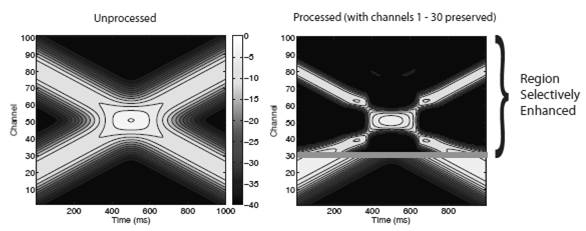Medical Devices

Algorithm for Selective Enhancement of Speech Signals
WARF: P100334US01
Inventors: Rick Jenison, Keith Kluender, Joshua Alexander
The Wisconsin Alumni Research Foundation (WARF) is seeking commercial partners interested in developing a system and method for selectively enhancing audio signals to make speech sounds more distinguishable.
Overview
Hearing impairment rarely extends across the entire frequency range of hearing. Commonly, hearing loss is most severe at higher frequencies, although listeners can have selective losses at frequencies across the spectrum. At least two components of sensorineural hearing loss reduce listeners’ access to speech information. The first is a loss of sensitivity, which results in an attenuation of speech that may be corrected by making the signal louder and reducing noise. The second component is a loss of selectivity, which results in blurring of spectral detail, or distortion. Unfortunately, amplification of speech or contrast enhancement may not improve selectivity, and may even impede listeners’ ability to understand speech sounds.
The National Council on Aging reports that untreated hearing loss of any degree has significant consequences on people’s social lives, emotional health, mental health and physical well-being. Advancements in hearing aid performance have the potential to improve quality of life for more than 10 percent of the American population. A need exists for improved methods for speech processing and recognition.
The National Council on Aging reports that untreated hearing loss of any degree has significant consequences on people’s social lives, emotional health, mental health and physical well-being. Advancements in hearing aid performance have the potential to improve quality of life for more than 10 percent of the American population. A need exists for improved methods for speech processing and recognition.
The Invention
UW-Madison researchers have developed an audio signal enhancement system and method for speech processing, recognition and/or enhancement. Unlike traditional systems, this algorithm recognizes that contrast enhancement, when applied to non-pathological or unimpaired regions of the frequency spectrum, can actually impede a listener’s ability to understand the underlying speech. The system’s contrast enhancement algorithm and selective control mechanism provide a method to selectively manipulate or augment portions of an audio signal and allow other portions to be unenhanced or enhanced differently. As a result, this system can be used to preserve the ability of a listener to process the unenhanced or differently-enhanced portions of the audio signal.
The enhancement process is accomplished by dividing an input auditory signal into a plurality of spectral channels, and either performing or not performing enhancement on established subsets of the channels. Then the enhanced and unenhanced signals are combined to form a selectively enhanced output auditory signal.
The enhancement process is accomplished by dividing an input auditory signal into a plurality of spectral channels, and either performing or not performing enhancement on established subsets of the channels. Then the enhanced and unenhanced signals are combined to form a selectively enhanced output auditory signal.
Applications
- Digital hearing aid devices
- Speech recognition systems
Key Benefits
- Reduces distortion
- Selectively applies enhancement to frequencies affecting hearing
- Yields prolonged battery life through faster processing
Additional Information
For More Information About the Inventors
Related Technologies
Tech Fields
For current licensing status, please contact Jeanine Burmania at [javascript protected email address] or 608-960-9846
Figures
